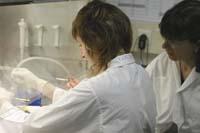Journalists with white apron

For a week, fifteen journalists from all over Europe, dressed in white apron, have entered the laboratory and have become scientists. Excuse, biotechnology and stage, the BioTalentum laboratory of G d ll, Hungary. They work with stem cells, clonan animals... a scenario that can generate debate and, therefore, attractive for journalists.
And the country. Hungary joined the European Union in 2004 and in 2005 the Hungarian government defined the scientific strategy, since the Hungarian government aspires to be the European leader in biotechnology to compete with Asia and the United States. The field is not new in this country; the term biotechnology was first used by a Hungarian in 1919, engineer Karoly Ereki. And it follows its path opened in the laboratory BioTalentum, one of the 70 Hungarian companies in the world of biotechnology.
At 9.00 in the morning, we reached 15 people from England, Holland, Italy, Bulgaria, Lithuania, Czech Republic, Poland and other countries. He has chosen us EURAC to be part of the My Science program. Unique objective: Train professionals who will intervene in the work of increasing the understanding of science by European citizens and provide resources for their performance. The selected have two common characteristics: journalists and young people.
The scientist Andras Dinneys receives us. He is the creator of BioTalentum and with his first words I understood why we are in this laboratory. Here was born the mouse Klonilla, the first cloned animal in Hungary. Then came the rabbit, Tapsilla. It is no coincidence. Dinneys cloned Dolly at the institute and returned to his village when he thought there were adequate conditions.
Before putting on the white apron, we have talked about ethics, how to do journalism and the communication of science. The harmony is total: knowledge must be shared. There will be difficulties. The scientist always wants the news to be positive; the journalist does not necessarily. And, often, the limit of the journalist will be to contrast in 24 hours the result of the 20-year study he has received through press release. But the problem does not have an easy solution.
The presentations of the researchers have come from behind. From home, some simple queries in the encyclopedia of Science and Technology and some that have given more games. They have also released some headline phrase: "We are surely eating cloned animals," or "we are talking about socially under-accepted techniques. But Asia and the US are too and competition is there. What do we have to do, forget everything and then import it?"
Then the procedures. Unfortunately, instead of live, we have known animals through a video recorded in the laboratory where there is a higher floor. And I have been wanting to know the house of animals. Too curious? It is possible. On the screen we have seen to test the operation carried out in a mouse before being human. Anesthesia, scalpel... Thinking I can use Teknopolis for the TV show, I have requested video. Asking is free… not giving. "This is not a show", replies Dr. Ana Claudia Carstea. It fears the activists. He does not believe that society is willing to see work with animals. That should be our work, the work of any journalist.
Two days after much information, many notes and so many others, we are ready to enter the laboratory. Dressed in aprons and white gloves, we have worked on basic tasks. We look from the microscope and "look, sperm at full speed". It could be anything else... but sex always works in the headlines. Pipettes, centrifuges, the importance of sterilization, DNA cutting... we have worked on mechanical tasks. With apparently small but expensive tools in money, great things are done in the laboratories.
We have played. And all that we have touched has gone into the garbage. Just in case! We have spent a week inside the laboratory, but abroad we have come to talk about a beer -- why not -, long and extensive. Hungarian scientists have taught us their knowledge and their work. They told us everything without complexes when there was no camera in front. Before the camera, Dr. Szilard Bodo is willing to talk, but not to talk about his private life. It is not authorized, a strategy is necessary to win the race.
The information is valuable. And show all the forces to the rival, in this case to the competitor, has never been a good strategy to win. Reason. But, although we respect the strategy, how are we going to tell people the race that we have not been able to give live? We can count what they told us, we can dress with the white apron, we can participate in European programs, but once the race has finished, we will inform the people of the race. They did not know that it was going to be done.
However, researchers are not the only ones competing in the races. In the newsrooms we want to be also the first. Living with researchers working with difficult and complicated issues has been a good experience. Would it be a good experience to remove the apron and introduce scientists into the writing for a week? Challenge launched. That whoever wants to take it.





